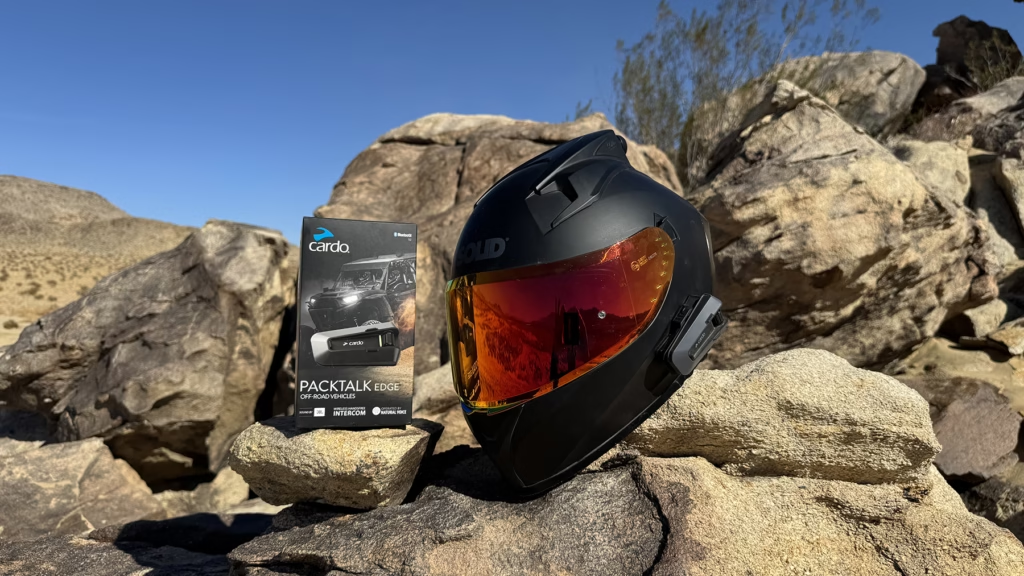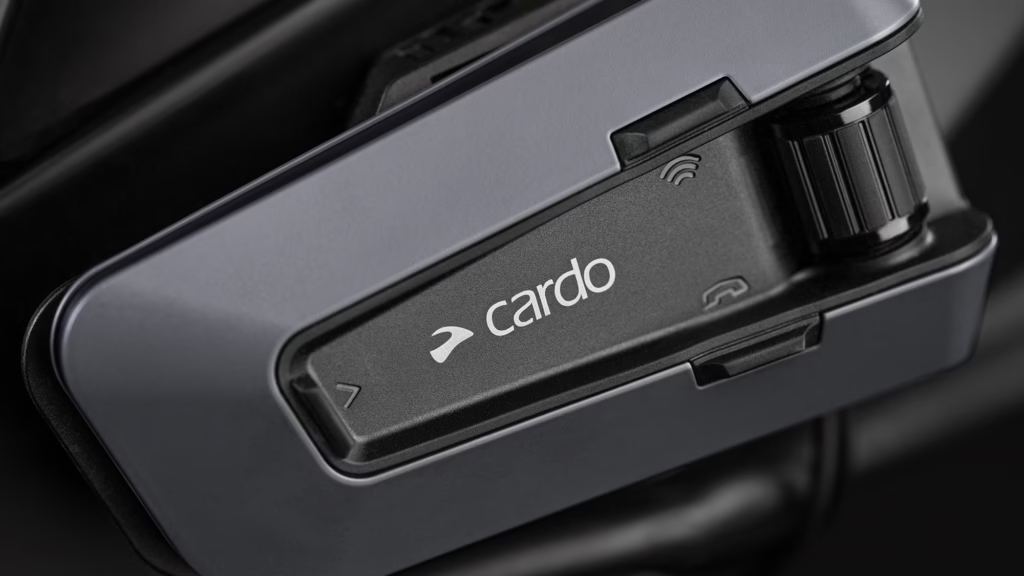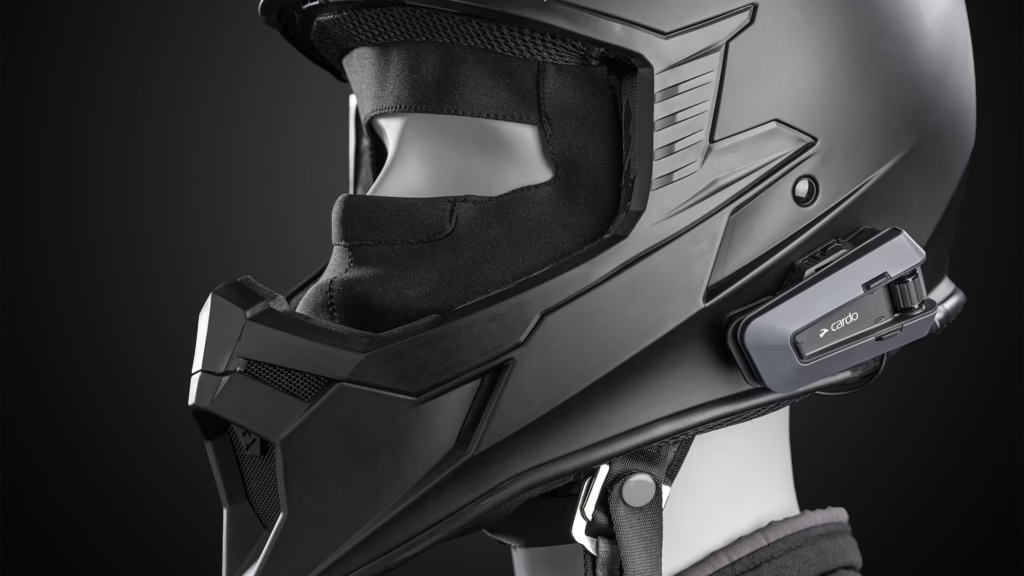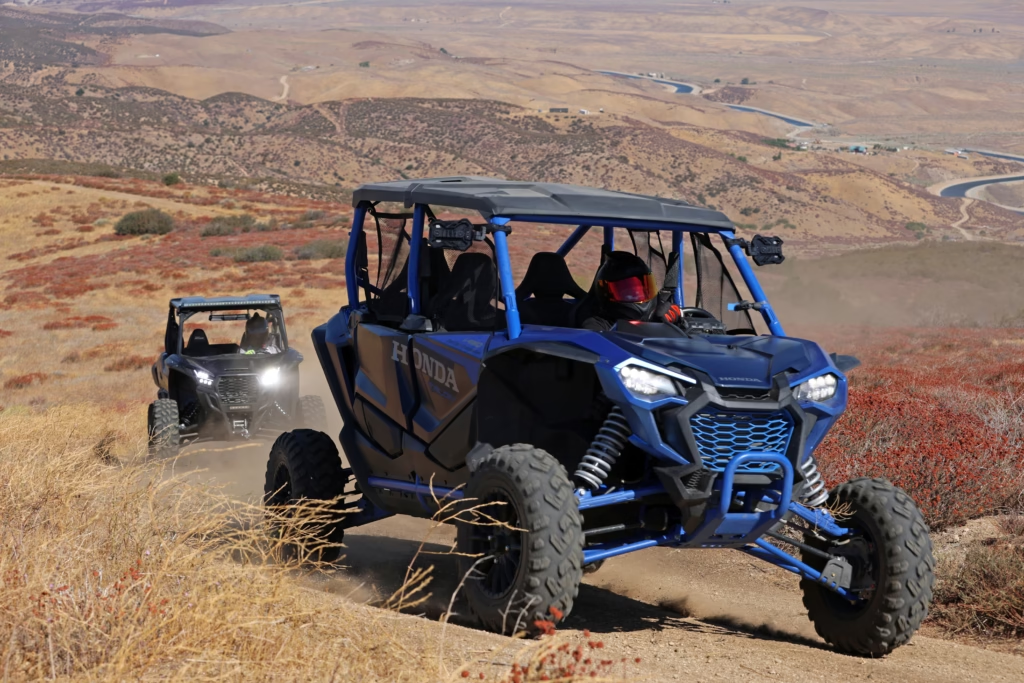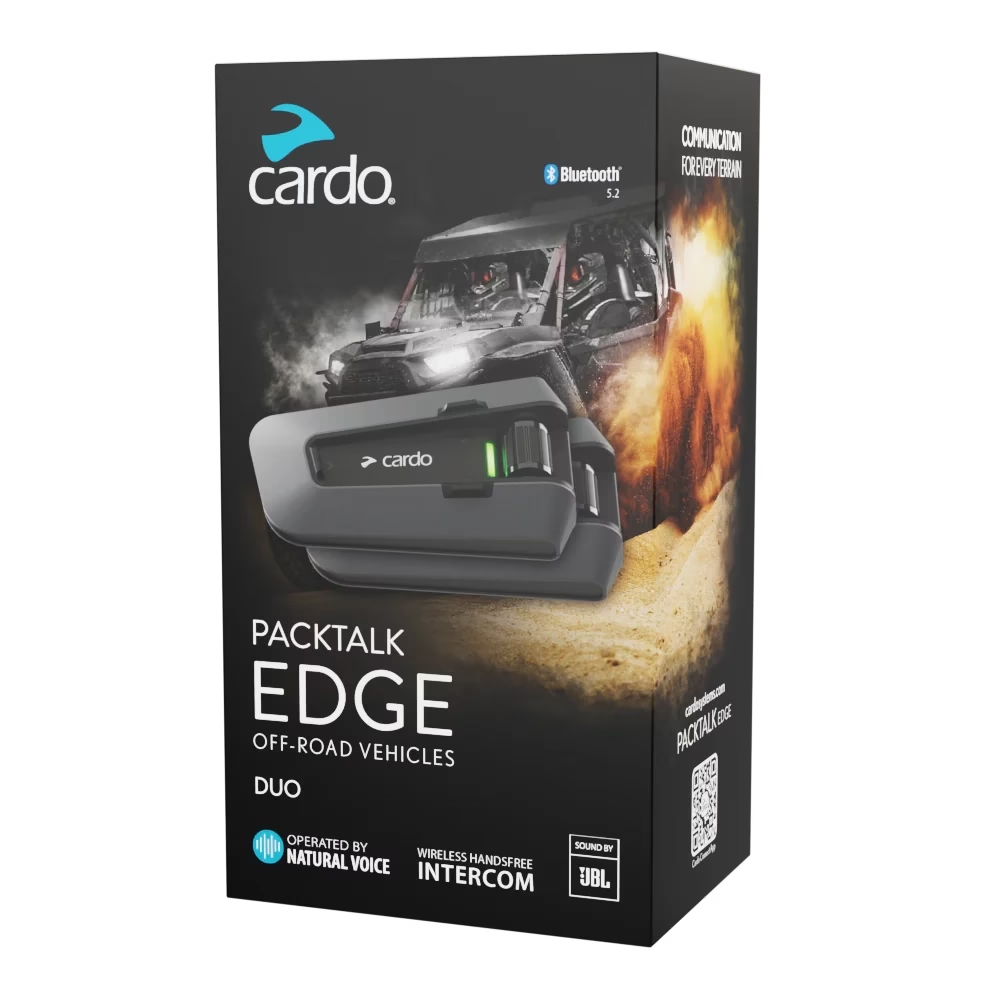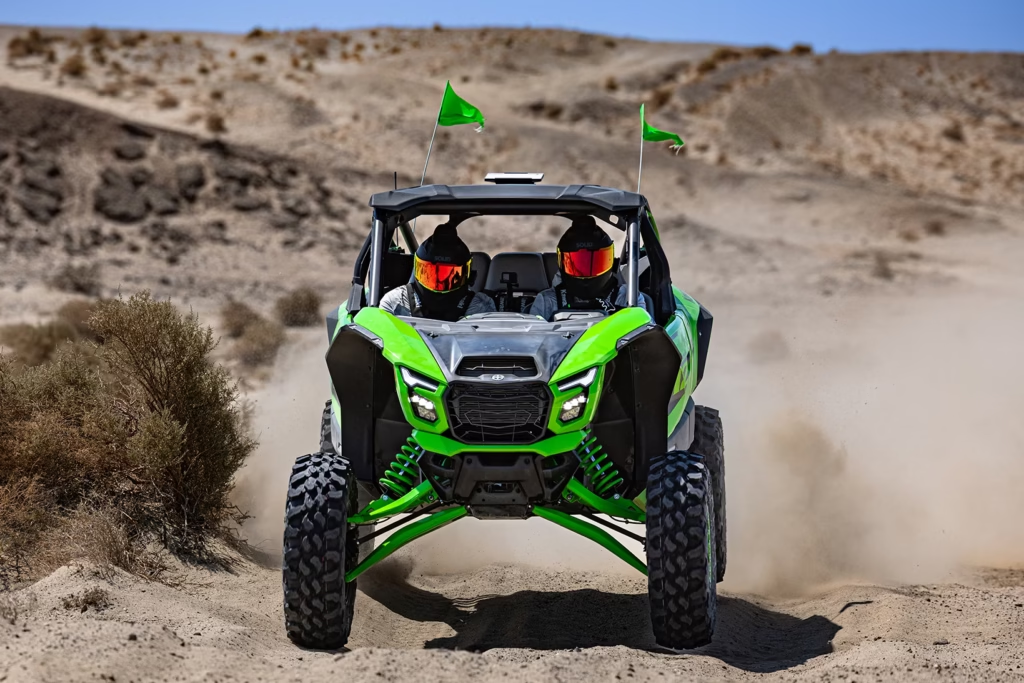There are few things less glamorous than communication gear. Headsets, mics, little boxes with blinking lights—all promising “seamless connection” while you’re screaming inside the cabin of a Mav R at full speed (well, your full speed) through a helmet filling up with dust. And subsequently, so is your mouth. It’s the tech equivalent of socks for Christmas: practical, necessary, but rarely exciting. Our Cardo Packtalk Edge ORV Review shows why traditional radio and intercom might not be necessary in your UTV or Side by Side.
There’s also a particular brand of chaos that happens when you’re deep in a trail system with five friends, zero cell service, and someone ahead just spotted a washed-out section, a herd of donkeys, or any other hazardous obstruction. You’re watching hand signals deteriorate into interpretive dance. Someone’s yelling something important, but all you hear is wind and your own engine. In my case, a playlist cranked to an offensive level.
This is the tax we pay for group rides—the communication breakdown that turns coordination into guesswork.
I’ve heard feedback from friends for years arguing Cardo’s dominance over the competitors, so I was pretty eager to test the Packtalk Edge ORV for myself. It came to me in understated casing—all matte finish, JBL branding, and bold talk about “Dynamic Mesh Communication 2.0.” I wasn’t expecting much but don’t balk at clean, unfussy packaging. After all, comm systems tend to overpromise and underperform, and the “ORV” badging sounded more like a rebrand than a revolution.
But after a few long opportunities to test—through rain, wind, and one regrettable mudhole—I’ll admit it: this one stuck. Not because it’s perfect, but because it’s the first system I’ve used that actually “disappears” once you start riding. And in a world of gear that constantly demands attention, that’s saying something.
Cardo Packtalk Edge ORV Review
What the “ORV” Badge Actually Means
Let’s be clear up front: the “ORV” badge is pure marketing. This is identical hardware to Cardo’s regular Packtalk Edge. Same guts, same capabilities, different box. If you find the standard Edge on sale, grab it.
Out of the box, the Packtalk Edge ORV looks and feels like high-end gadgetry. The module is compact but sturdy, with the sort of design confidence that implies someone at Cardo actually rides. What matters most is what’s inside: Dynamic Mesh Communication 2.0—a self-healing network that connects up to 15 riders. When someone inevitably takes a wrong turn, the mesh repairs itself. They drop out, they come back in. No button mashing required.
The Magnetic Air Mount clicks into place with a satisfying thunk—glove-friendly, idiot-proof, and surprisingly secure even in the chaos of off-road abuse. Pop it off to charge, snap it back on even with gloves on. That confident “clack” when it locks is oddly reassuring. It’s the kind of detail that feels small until you’ve lived with it—like discovering your favorite jacket has hidden pockets.
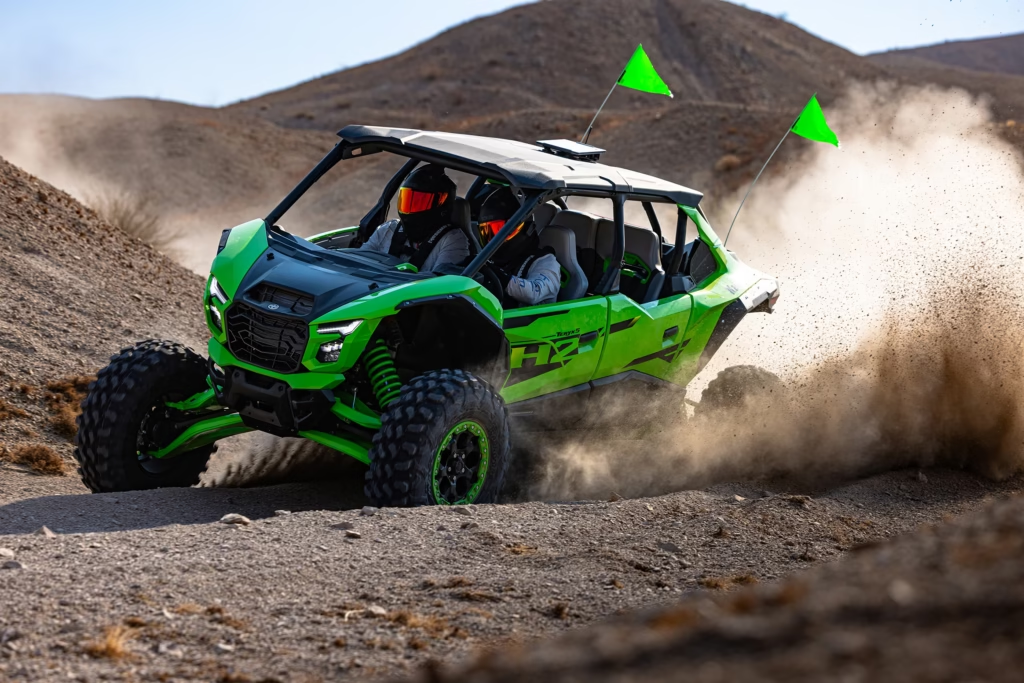
Inside live 40mm JBL speakers that actually sound good. They’re no joke: crisp at high volume, rich in the midrange, and more capable of drowning out wind noise than any system I’ve tried short of custom ear monitors. It’s powered by Bluetooth 5.2, wrapped in IP67 weatherproofing, and backed by a 13-hour talk time with a long-lasting battery that charges via USB-C.
The spec sheet promises a 1-mile rider-to-rider range, extending up to 5 miles with a full group mesh. In open desert, it’s believable. In dense woods, perhaps a bit less so. But what’s impressive is how gracefully it fails—instead of dropping everyone like a bad Bluetooth date, the mesh quietly self-heals, reconnecting riders the moment they’re back in range.
Weighed against wired comms systems, the Packtalk Edge is cheaper, sound quality is superior, and, of course, you’re not tethered to…anything. And while this side-by-side seems almost too obvious, there’s really not an apples-to-apples comparison to Cardo’s systems—even when we’re speaking solely on the mesh technology.
Cardo Packtalk Edge ORV Review
Getting Started, No Manual Necessary
The magnetic mount is satisfying in a way that nails on an old keyboard, a solid cracked knuckle, and a well-landed jump are satisfying. Align it, let the magnets do their thing—done, even with gloves on. Thoughtful design. While it’s not foolproof (I’ve managed to botch a few docking attempts), the odds are good for the average rider.
Then you open the manual. Let’s be clear: the written instructions are not your friend. They read like an IKEA manual translated by AI. Skip it. Head straight to the Cardo Connect app, and setup becomes intuitive. Pairing takes seconds. Firmware updates happen over-the-air.
Speaker placement is critical. Those JBL drivers need to sit directly over your ears. Too far forward, and your crew sounds like they’re talking through a soup can. Too far back, and you’ll think they’re whispering from another planet. Spend the extra ten minutes to position them correctly, and the payoff is instant: deep, full sound that somehow cuts through the drone of your tires and the roar of a turbocharged UTV.
Once it’s dialed in, the day-to-day operation is where this system earns its keep. If you’ve ever wanted to feel like you’re talking to your helmet, the “Hey Cardo” voice control system actually works. Commands like “volume up,” “music off,” or “next track” land almost every time, even at 40 mph with your visor cracked open. It’s not flawless, but it’s good enough to make the buttons redundant. Your hands stay on the wheel.
Cardo Packtalk Edge ORV Review
Earning the IP67 Rating
I was skeptical. Communications gear lives in that frustrating space where every product makes identical claims, and most deliver mediocre results.
The Edge ORV cleared the bar.
Plenty of comm systems claim “ruggedness” only to short out after a drizzle (or the first time your arm knocks it on the ground). The Edge ORV seems, for all intents and purposes, genuine in its decree. With an IP67 rating, it survived dust storms, full submersion in mud spray, and one moment where my friend accidentally dropped it straight into a wheel-high mud puddle while we were filming content. It raged on, albeit a bit wetter. No hesitation, no water intrusion, no drama. The rating isn’t marketing speak.
In the real world, the 13-hour talk time feels accurate. There might have been long stints between rides, and even longer days in the saddle, yet this didn’t seem to affect the battery life. In the rush of loading and unloading my gear for various work events or side-by-side excursions, I often forgot—and sometimes chose—not to charge the device. You know, for science…and not because I’m irresponsible.
Most days, I’d ride dawn to dusk and still have juice left. And when I didn’t? A 20-minute USB-C top-up delivered a couple more hours of chatter. There have been multiple occasions, as you might guess, where my Packtalk Edge was dead on-site and plugging it in during a pitstop, morning coffee, or the ride to the trail gave enough power to keep me in contact with my crew throughout the day.
The JBL audio delivers crisp voices and surprisingly good bass. Audio quality remains stellar even when chaos erupts. Voices come through clear and natural, music doesn’t distort at high volumes, and the automatic volume adjustment feels smarter than expected. It’s not just loud—it’s adaptively loud. In a convoy of UTVs tearing through desert washes, the intercom stayed clear.
Competitors often falter when reality hits: moisture seeps in, connectors corrode, and housings crack after a few hard landings. The Edge ORV’s sealed construction, reinforced casing, and corrosion-resistant contacts give it a clear advantage in longevity. Riders who put their gear through real-world abuse—mud runs, desert dust, freezing rain—will find it keeps operating long after other units have called it quits.
Even after extended use, audio quality and connectivity remain stable. The mesh network stays linked despite drops, vibration, or distance, and the battery consistently delivers full-day performance. This is communication gear built for endurance—hardware that’s meant to be forgotten while it quietly does its job, ride after ride, season after season.
Cardo Packtalk Edge ORV Review
Performance & Practicality
That 1-mile range? Real in open terrain with clear line-of-sight. In forests or mountains, expect closer to a few hundred yards. The mesh networking helps extend group coverage, but physics is still physics. Range drops fast in tight canyons or forests.
High-speed wind noise can overwhelm the system if you’re running an open-face helmet. And in particularly loud UTVs—think straight-piped Can-Am or turbocharged side-by-sides—even the JBL speakers struggle. That’s where Cardo’s Edgephones accessory comes in: over-ear, noise-reducing headphones designed for the same DMC mesh. They’re not included (and not cheap), but they turn the Edge ORV into a near-perfect solution for side-by-side convoys.
They’re also ideal for mixed groups—the kind where one friend’s in a RZR, another’s on a quad, and someone’s brought a dirt bike “just because.” One system, one language, zero frustration.
A few riders reported minor audio echo when bunched up close together, but it was fleeting. Not a dealbreaker.
Cardo Packtalk Edge ORV Review
Addressing Sticker Shock
At around $400 for a single unit or $730 for a duo pack, the Packtalk Edge ORV is premium—and expensive—gear. Outfitting a full crew gets painful quickly.
If your idea of off-roading is a casual fire road once a month, you can find cheaper comms. But this is premium gear for a specific kind of rider. If you lead group rides, run tours, or need one reliable system that works across helmets, UTVs, and motorcycles, the value proposition makes sense. You’re buying seamless coordination, safety, and reliability that doesn’t make you curse technology mid-ride. For those who ride often—guides, group leaders, rally nuts, weekend diehards—it’s worth every dollar.
Compare it to cheaper options and the difference becomes obvious. Those $150 systems work until they don’t. Then you’re troubleshooting at gas stations and missing turns because someone’s unit dropped out.
The main drawbacks? Range drops fast in tight terrain. The module itself isn’t exactly sleek. And the charging port’s little rubber latch feels like it might give up before the warranty does. Otherwise, the system just works. Which, ironically, is the highest compliment you can give a piece of tech meant to be forgotten once you start the engine.
Plus, the Edge ORV comes with a 3-year warranty. That’s confidence.
Cardo Packtalk Edge ORV Review
Who Needs This (And Why It Matters)
Buy this if you lead group rides and are tired of playing communication referee. If you run tours or rentals and need bulletproof reliability. If you ride multiple vehicle types and want one system that just works for everything. If you value “set it and forget it” over saving a few hundred bucks. This unit also pairs seamlessly with the Edgephones “Beats by Dre” style headset so any spotters out in your group can jump out and give you crucial directions down a complicated chute.
But, aside from that, as a solo wanderer who rides to escape the noise, staying connected solely to check in with loved ones or chill with a preferred playlist, skip this. If you’re budget-conscious, check out Cardo’s Packtalk Neo instead. Other brands like Sena Bluetooth are similarly popular and priced in the same bracket as Cardo. But it’s reputed their systems endure a few more issues—some shared with Cardo, others unique to Sena—but that’s a story for a different time.
Cardo Packtalk Edge ORV Review
The Bottom Line
The Cardo Packtalk Edge ORV makes you slightly annoyed at how well it works. Because now you can’t justify settling for cheaper alternatives. It’s rugged, smart, and versatile enough to swap between your UTV, your adventure bike, and your buddy’s ATV. It’s also refreshingly intuitive. After the initial setup, there’s nothing to think about. No troubleshooting. No re-pairing. Just turn it on, and talk.
Yes, the “ORV” branding is marketing. Yes, the price will make your wallet wince. Yes, the installation instructions are useless. But if you’re serious about group riding and want communication that actually works when you need it—20 miles from cell service, covered in dust, trying to coordinate around an obstacle—this is the best option available.
I started testing this system expecting the usual compromises. What I had instead was a piece of gear that fundamentally changed how my group rides. We went from yelling and hand signals (or silence) to coordinated movements. One buddy put it best after our first ride with the full crew on comms: “I didn’t realize how much we were missing until we could actually talk.”
No communicator can turn a nervous first-timer into a seasoned trail leader. But if you want your crew to sound as coordinated as they look, the Edge ORV delivers. In an era of overcomplicated tech, it succeeds by moving out of the way. It’s not trying to be your co-pilot, DJ, and social network all at once…or maybe it is. [Pensive pause.] But it nonetheless lets you stay connected when it counts—through mesh, mud, and all the moments in between. Just be prepared to pay for it—though most good things in life require a bit of investment. Fortunately, you can save 10% by following this link or using code UTVOR at checkout.
ALSO SEE: Top Helmet Intercom Buyer’s Guide
Cardo Packtalk Edge ORV Review
Tech Specs
| Feature | Specification |
| Range | 1 mile rider-to-rider, up to 5 miles group mesh |
| Battery Life | 13 hours talk time |
| Charging | USB-C fast charging (20 min = 2 hours talk) |
| Group Size | Up to 15 riders |
| Waterproof Rating | IP67 |
| Audio | 40mm JBL speakers |
| Connectivity | Bluetooth 5.2 |
| Warranty | 3 years |
| Price | ~$400 single, ~$730 duo pack |


